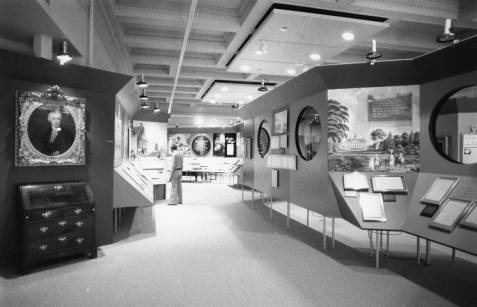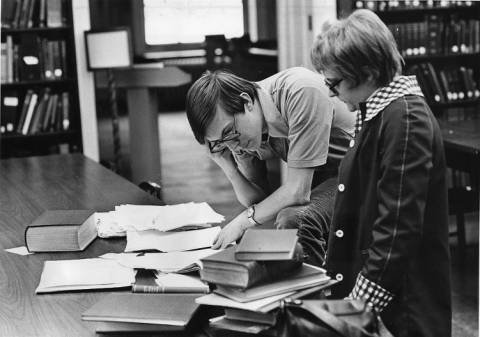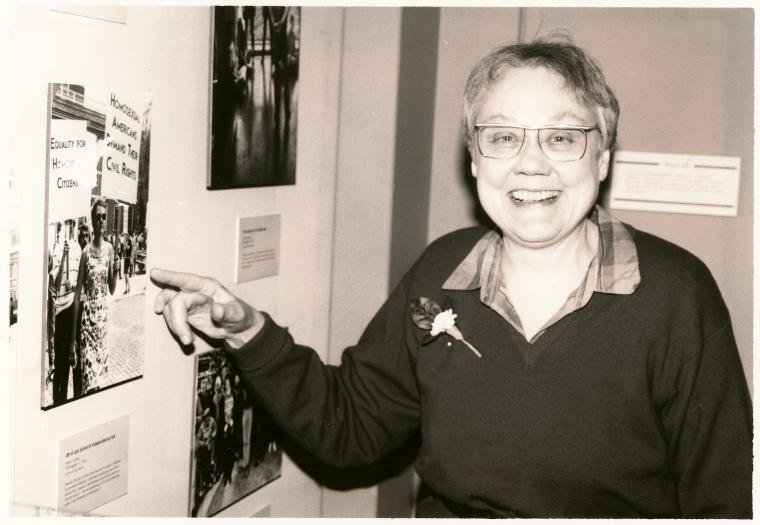After a brief hiatus (Spring Break), we @phillyhistory students are back Steeming ahead. This week, we are discussing the funding ideas we proposed (Part 1 and Part 2) and blogging about the late '90s decision by the Historical Society of Pennsylvania (HSP) to transfer most of its museum collections to the Philadelphia History Museum, not to be confused with @phillyhistory, which can be found at www.phillyhistory.org. Other meditations on these readings by @dduquette @peartree4 and @hourofhistory are here, here, and here respectively.

Photo of an exhibit at the HSP circa 1976 from Temple University Special Collections Research Center
The Crisis
Reading the Harvard Business School case study of HSP ca. 1997 was fascinating reading. This was an organization that not only was not ready for the 21st century, it seemed never to have left the 18th. Board members thought of it as a social club and only secondarily as a steward of historical material.
I recognized things to appreciate about the HSP of the 1980s before its management pivoted. For the scholars who patronized the society it must have been a wonderful research center. Artwork on the walls and fine antique surroundings probably gave new researchers a heady sense of having made it into an elite circle.

Photo of researchers at HSP ca. 1975 from Temple University Special Collections Research Center
Yet it was that elitism that was the problem. And the sexism. And the hemorrhaging of cash. So beginning in 1990, HSP hired a new executive, Susan Stitt, who assessed the situation over the next few years and presented the board with options for the Society's survival. One of them was the ill-fated Philadelphia History Center. Another involved severe austerity measures.
The middle option, in which the HSP deaccessioned its art and artifact collection, was what eventually prevailed, with most of that material handed over to the Philadelphia History Museum (then still called the Atwater Kent Museum) in 1999.
Outcomes
Today, the HSP is a much less exclusive space--if you are a student. I had a pleasant time on my one excursion to the reading room there, though I confess I got a little confused by the finding aid I was trying to use. It still comes across as a venerable and moneyed sort of place. I wonder, reading the Harvard case study, if the endowment has rebounded since the mission pivot two decades ago.
HSP still does some limited work with exhibits. For instance, I found the photo below in the digital collections of the New York Public Library. It shows Barbara Gittings at the "Pennsylvania Historical Society," which I think must be HSP, in 2001.

Photo of activist Barbara Gittings at an exhibit on Gay Rights at HSP(?) ca. 2001, from the Barbara Gittings and Kay Tobin Lahusen gay history papers and photographs collection at the New York Public Library
The Philadelphia History Museum still exists, though its future is once again in doubt. The last time I was there I remember a room of colonial-era portraits that must have once been part of the HSP collection.
What did we learn?
I think that Susan Stitt's austerity measures at the HSP in the early 1990s probably saved the institution. The articulation of a public mission may be more concept than reality, but the institution persists and was the structural scaffold behind the Hidden Collections Initiative a few years ago that allowed small historical institutions to adequately process their archival material.
For PHM, the jury is still out. The museum's focus has always sort of clashed with the colonial messaging of the nearby cultural institutions in Philadelphia's Old City.
The transfer of assets seems to have worked for one party, but not necessarily the other. As we discuss mergers in class this week, I suspect that we'll find similar trends. These sorts of partnerships in the cultural world come with plenty of strings attached and unequal power relationships that do not always work out in everyone's best interest.
Do check out the summaries of my classmates' pitches (Part 1 and Part 2) and let us know what you think about them! What would you like to see if you were a visitor to Philadelphia? What might impact your life if you lived here? Chime in!
100% of the SBD rewards from this #explore1918 post will support the Philadelphia History Initiative @phillyhistory. This crypto-experiment conducted by graduate courses at Temple University's Center for Public History and MLA Program, is exploring history and empowering education. Click here to learn more.
Just to clarify, when you say
are you suggesting it worked better for HSP, which unburdened itself of a labor intensive part of its program that competed with it's research function? And are you saying it didn't benefit the AKM (a.k.a. the PHM)?
I wonder if a closer look at the AKM collection with HSP's artifacts might suggest that the museum was buoyed with cultural and financial assets. Consider the rationale behind & impact of these two very lucrative sales: 1) a Raphaelle Peale painting in 2009:
and in 2011 this portrait of Yarrow Mamout by his dad, C.W. Peale:
Can't we conclude that the PHM was at least partially enriched by the transfer? And enhanced in reputation (in a perverse way)?
For sure! Any judgement I passed is premature since I really don't know much about the current states of these organizations other than what I hear from you!
But one can speculate. Imagine. Inquire. Comparing the relative impact of the collection transfer on both orgs would be a juicy challenge.
There's way too little evaluation and transparency about these scenarios... Who will do the heavy lifting? Grad students? Consulting firms? The orgs themselves? We have so much to gain by honest, clear-eyed analysis...